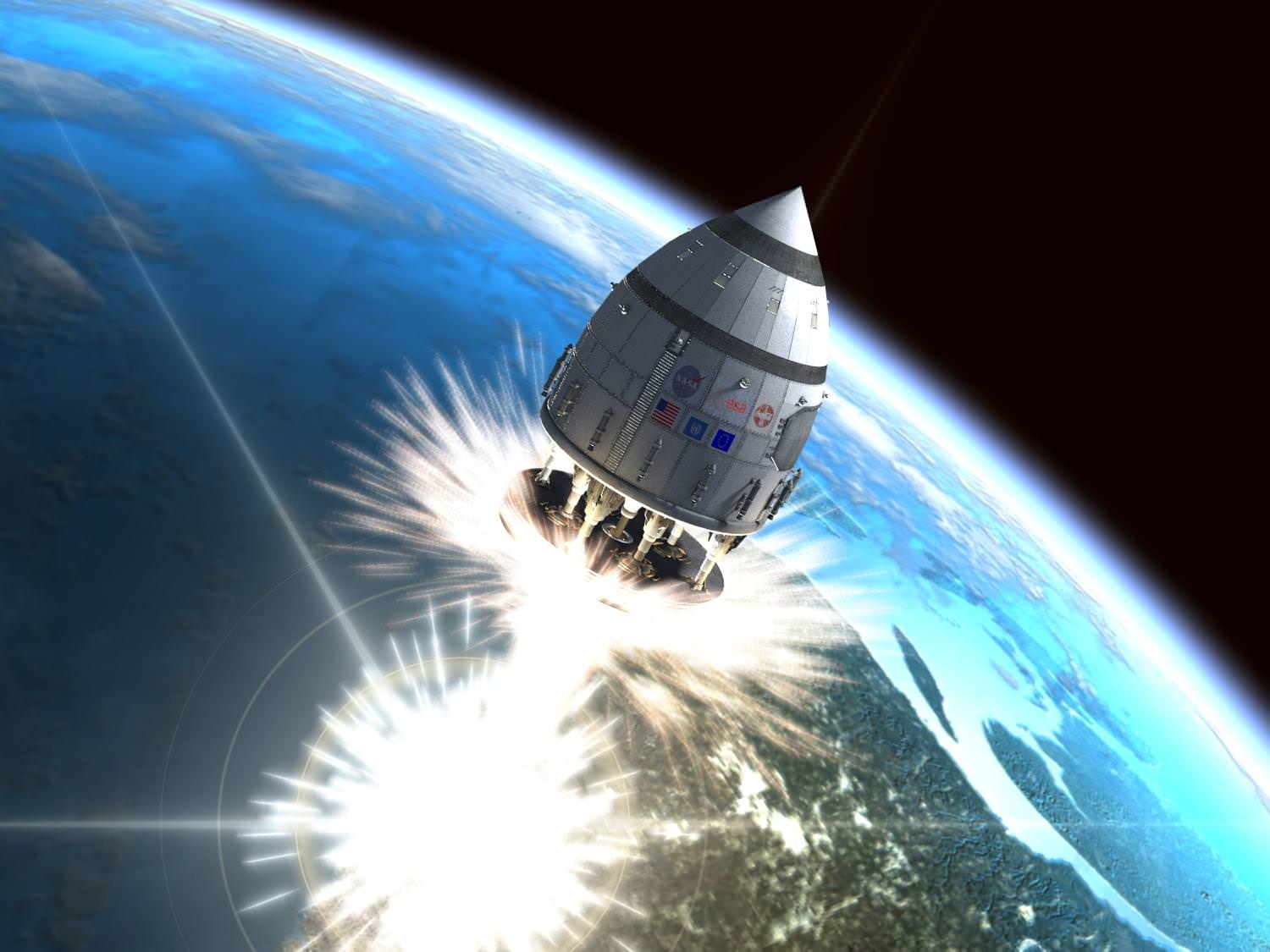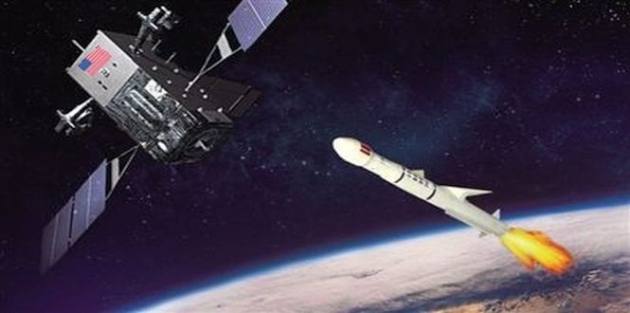
The US Space Force and the Dangers of Nuclear Power and Nuclear War in Space
Karl Grossman / A Publication of Beyond Nuclear
Acknowledgements
This booklet came about at the initiative of Professor Karl Grossman, who is its lead author. Professor Grossman is a professor of journalism, prolific author, and broadcaster. He is a member of the Beyond Nuclear board of directors. His expertise on this issue was indispensable. We are also deeply grateful to the longstanding work of Bruce Gagnon and his organization, the Global Network Against Weapons & Nuclear Power in Space. Gagnon’s deep knowledge and extensive informational output formed an essential foundation for the content you find here. We are also thankful to Beyond Nuclear founding president, Dr. Helen Caldicott, who has written and spoken frequently on this issue and has never failed to remind us of the inextricable link between nuclear power and nuclear weapons.
Introduction
Beyond Nuclear is publishing a series of informational booklets that, taken together, comprise The Case Against Nuclear Power: Facts and Arguments from A-Z. To date, we have focused on nuclear power on Earth. But there are ominous developments that could propel nuclear power into space, for the purposes of war.
With the creation of the US Space Force, such a development moved one step — or maybe several steps — closer. When space is viewed as “a warfighting domain” that could utilize nuclear-powered battle platforms and lasers, we have no choice but to extend our opposition to nuclear power beyond Earth’s boundaries.
Weapons in space have historically been justified as necessary for “defensive” purposes. But that all changed on May 15, 2020 when Trump, while unveiling the Space Force flag, declared: “Space is going to be … the future, both in terms of defense and offense [emphasis added].”
The nuclear weaponizing of space has, to date, captured too little attention among politicians and the press. This booklet is intended, in some small way, to help redress that imbalance.
Every booklet in our series is posted on the Beyond Nuclear International website where it is available for free download. Printed copies can also be ordered from Beyond Nuclear. We hope you will distribute this booklet widely and join us in keeping space for peace.

What Is the Space Force?
The US Space Force was initiated by the Donald J. Trump administration as a sixth branch of the United States armed forces. The Space Force was officially established on December 20, 2019 when Trump signed the National Defense Authorization Act (NDAA) for 2020, a $738 billion military policy bill that provided funding for its creation.
In announcing the Space Force, Trump said: “It is not enough to merely have an American presence in space, we must have American dominance in space.” In signing the NDAA setting up the Space Force, he stated: “Space is the newest warfighting domain”. With a US Space Force, Trump said, the US would “control the ultimate high ground.”
Why Do We Need a Space Force?
We don’t. A Space Force will weaponize space, increase the likelihood of war in space, and could potentially introduce the use of nuclear-powered battle platforms in space.
The official reason, as asserted by Trump and the US military, is that a Space Force is needed because China and Russia have been moving into space militarily. But it appears that the true aggressor is the US
China and Russia — along with Canada — have led efforts for decades to expand the Outer Space Treaty of 1967 and ban all weapons in space. The
Outer Space Treaty provides that nations “undertake not to place in orbit around the Earth any objects carrying nuclear weapons or any other kinds of weapons of mass destruction, install such weapons on celestial bodies, or station such weapons in space in any other manner.”
China, Russia and Canada have led calls for the ratification of the Prevention of an Arms Race in Outer Space or PAROS treaty, barring all space weaponry. But although the PAROS treaty has had overwhelming support at the United Nations, year after year the US has voted against it, vetoing its passage.
China’s foreign ministry spokesman, Geng Shuang, called the creation of a US Space Force “a serious violation of the international consensus on the peaceful use of outer space” and a “direct threat to outer space peace and security.”
Viktor Bondarev, the head of the Russian Federation Council’s Defense and Security Committee, responded that “militarization of space is a way to disaster,” and that Russia would “strongly retaliate.”
Despite pushing for years to expand the Outer Space Treaty and to forbid the deployment of any weapons in space, Russia and China will not sit back as the US forms a Space Force and seeks “American dominance in space”. They will meet the US in kind. And they will likely be followed by other nations, turning space into a war zone.

How Did the Space Force Come To Be Created?
Trump’s call for a Space Force “started off as a joke,” according to reporting by Claudia Grisales of National Public Radio. “Trump riffed on an idea he called ‘Space Force’ before a crowd of Marines in San Diego. He drew laughs,” Grisales relayed in a 2018 broadcast. Trump subsequently said: “And I was not really serious. Then I said, ‘What a great idea, maybe we’ll have to do that.’”
The Space Force was made possible with the passage of the $738 billion National Defense Authorization Act, which was passed by the US House on December 11, 2019 and the US Senate on December 17. It was supported by 189 Republicans and 188 Democrats in the House. The Senate vote was 86 to eight with 48 Republicans, 37 Democrats and one independent (Senator Angus King of Maine) in favor.
The New York Times attributed the large Democratic vote in the House to a trade-off for paid parental leave for civilian federal employees (common in countries all over the world) orchestrated by Jared Kushner, Trump’s son-in-law and advisor. Said The Times: “It was Mr. Kushner who helped broker a deal to create the Space Force, a chief priority of the president’s, in exchange for the paid parental leave, a measure championed by his wife, Ivanka Trump, also a senior advisor to the president.”

How Much Will It Cost?
According to Space News, Air Force Secretary Barbara Barrett, in a December 2019 memo, “requested the following transfers to the Space Force for fiscal year 2020: $9.3 billion from Air Force space related weapons systems and operations, $1.4 billion from weapons system sustainment, $275 million from major command support, $26.3 million from education and training, $95 million from headquarters spending.” And Trump, in his proposed fiscal year 2021 budget, is proposing $15.4 billion for the Space Force. The Space Force, if it is allowed to continue, will clearly be a multi-billion dollar annual affair.
Who Will Pay for It?
The aerospace industry has suggested defunding “entitlement programs” to pay for “everything space.” That would likely include cutting Social Security, Medicare, and Medicaid among other social and welfare programs.
As Michael Hiltzik, business columnist for the Los Angeles Times, reported in regard to Trump’s proposed fiscal year 2021 national budget: “Trump’s proposed $4.8-trillion budget for the 2021 fiscal year makes his intentions crystal clear: He means to shred the federal safety net for the poor and the sick…. The budget proposal released Monday calls for drastic cuts in Social Security and Medicaid benefits…”

Who Will Profit?
Raytheon is emerging as a major beneficiary of Space Force work. Perhaps not uncoincidentally, Mark Esper, Trump’s US Secretary of Defense at the time the Space Force was announced, is a former lobbyist for the corporation. Other major contractors for the Space Force will be Northrop Grumman, Boeing and Lockheed-Martin, the world’s biggest military contractor.
The aerospace industry has suggested defunding “entitlement programs” to pay for “everything space.” That would likely include cutting Social Security, Medicare, and Medicaid among other social and welfare programs.
What is the Mission of the Space Force?
When Trump officially launched the Space Force on December 20, 2019, by signing NDAA into law at Joint Base Andrews, he declared: “Space. Going to be a lot of things happening in space…. Today marks a landmark achievement as we officially inaugurate the newest branch of our military, the US Space Force. This is a very big and important moment”.
This was echoed by Esper, who declared that, “today outer space has evolved into a warfighting domain of its own”, and that there needs to be US “dominance in that domain.”
In March 2020, the Space Force deployed its first “offensive weapons system” designed to “deny adversary satellite communications.” It is an upgraded version of a ground-based satellite communications jamming system.
And there are more — classified now and to come. “Space Force Just Received Its First New Offensive Weapon,” was the headline on the website The Drive, in a section tellingly called The Warzone. The subhead read: “This is just one of two acknowledged US ‘counterspace’ capabilities, but there are more in the classified realm.”
Meanwhile, US Air Force bases across the United States are being renamed US Space Force bases. Components of the Air Force being absorbed into the US Space Force include its 50th Space Wing. Above the entrance to its headquarters in Colorado are emblazoned the words: “Master of Space.”

The Space Treaties
The Space Force is in direct violation of almost universally agreed language at the UN level that space should be a global commons to be used for peaceful purposes.
• Outer Space Treaty: Enacted in 1967, the treaty was created by the United States, the United Kingdom and the then Soviet Union. It has been signed onto or ratified by 132 nations. It declares that “the exploration and use
of outer space shall be carried out for the benefit and in the interests of all countries and shall be the province of all mankind; outer space shall be free for exploration and use by all States; outer space is not subject to national appropriation by claim of sovereignty, by means of use or occupation, or by any other means.”
It declares that, “States shall not place nuclear weapons or other weapons of mass destruction in orbit or on celestial bodies or station It declares that, “States shall not place nuclear weapons or other weapons of mass destruction in orbit or on celestial bodies or station them in outer space.”
• The Prevention of an Arms Race in Outer Space (PAROS) Treaty:
The treaty takes the form of a UN resolution that reaffirms the fundamental principles of the 1967 Outer Space Treaty and expands it to include a ban on every kind of weapon in space. It was created because the Outer Space Treaty “by itself does not guarantee the prevention of an arms race in outer space.” However, because of US opposition, the PAROS treaty has never come into force.

Earlier Attempts to Weaponize Space
US government and military interest in weaponizing space began after World War II when the US brought in more than 1,000 scientists from defeated Nazi Germany, including Wernher von Braun. Von Braun, who had been involved in the development of Germany’s V-2 rocket, worked on a modified version of it with colleagues, developing the Redstone, the first US rocket to carry a nuclear warhead.
German Major General Walter Dornberger, head of the entire Nazi rocket program, worked with the US Air Force to develop “a system of hundreds of nuclear-armed satellites all orbiting at different altitudes and angles, each capable of reentering the atmosphere on command from Earth to proceed to its target,” according to historian Jack Manno.
In 1989, a Congressional blueprint for space warfare — Military Space Forces: The Next 50 Years — also published as a book, was signed by House and Senate Democrats and Republicans who declared that, “The United States must provide a measure of control over space.”
In 1996, the then US Space Command drew up its Vision for 2020 report, whose declared mission was “dominating the space dimension of military operations to protect US interests and investment.” It envisaged that early in the 21st century, “space power will also evolve into a separate and equal medium of warfare.”
Vision for 2020 sees a US effort to control space — and from space control the Earth below — similar to how centuries ago, “nations built navies to protect and enhance their commercial interests,” the way in which the great empires of Europe ruled the waves and thus the world.
Fighting wars both from and into space was looked at as controversial yet likely.
“It’s politically sensitive, but it’s going to happen,” remarked US Space Command’s Commander-in-Chief, Joseph W. Ashy, in Aviation Week and Space Technology in August 1996. “Some people don’t want to hear this, and it sure isn’t in vogue — but absolutely — we’re going to fight in space. We’re going to fight from space and we’re going to fight into space…. We will engage terrestrial targets someday — ships, airplanes, land targets — from space.”
By 1998, the notion of fighting wars in space was well established. The US Space Command’s Long Range Plan of 1998 includes strategies for “Control of Space,” “Full Spectrum Dominance” and “Global Engagement”. It highlights the names of 75 corporations involved in the plan’s development. Among the 75 are some of the same proposed contractors for the US Space Force, including Lockheed Martin and Northrop Grumman.

“Star Wars”
US president, Ronald Reagan, was inspired to launch his “Star Wars” concept by Dr. Edward Teller, the main figure in the development of the hydrogen bomb. Teller’s plan centered on orbiting hydrogen bombs that would energize X-ray lasers. The official name of the program was the Strategic Defense Initiative, quickly nicknamed “Star Wars” but also known for short as SDI.
The original hydrogen bomb/X-ray scheme was scuttled in favor of other space-based weaponry, notably hypervelocity guns, particle beams and laser weapons. To manage “Star Wars,” a US Space Command was set up in 1985, dissolved in 2002, and reactivated in 2019.
It was Reagan’s fantasy about space weapons that derailed the opportunity for the US and the then Soviet Union to fully disarm and draw down their nuclear weapons arsenals. Then Soviet premier, Mikhail Gorbachev, had told Reagan before their famous 1986 summit in Reykjavik, Iceland, that if the US gave up the militarization of space, the Soviets would be willing to reduce all their nuclear forces to zero.
But Reagan refused to let go of SDI, a program that had not yet been invented and eventually developed into a deeply flawed and wildly expensive program that cannot deter or deflect incoming missiles with the essential 100% accuracy. While professing a desire to eliminate nuclear weapons, Reagan saw his space missile program as a guarantee against any failure by an opponent to do so. The Soviets wanted Reagan to confine the SDI research to the laboratory for the next ten years. But Reagan stubbornly refused.
In the end, as Jacob Weisburg described it in an article for The Atlantic in January 2016: “This seemingly minor disagreement about how long SDI research would stay confined to the laboratory blocked what would have been the most sweeping arms-control agreement in history.”

The Nuclear Connection
Nuclear power as an energy source for space weaponry has been advocated in US military documents and plans for decades. The original plan for Reagan’s first iteration of “Star Wars” was predicated on orbiting battle platforms with nuclear reactors and plutonium systems on board, providing the power for hypervelocity guns, particle beams and laser weapons, all of which require large amounts of energy.
A 1996 US Air Force Board report — New World Vistas: Air and Space Power for the 21st Century — emphasized the tie-in between space weaponry and nuclear power. The report saw nuclear energy as solving the power limitations of getting weapons of mass destructions into space. “A natural technology to enable high power is nuclear power in space,” said the report: “Setting the emotional issues of nuclear power aside, this technology offers a viable alternative for large amounts of power in space.”
As General James Abrahamson, director of SDI, declared: “Without reactors in orbit [there is] going to be a long, long light [extension] cord that goes down to the surface of the Earth” to power space weapons. “Failure to develop nuclear power in space,” said Abrahamson, “could cripple efforts to deploy anti-missile sensors and weapons in orbit.”
The US Space Force scheme is very much an encore of “Star Wars”, and the energy needed to power weapons that would be deployed in space would likely be nuclear-powered.

Who Opposes the Space Force?
The leading group internationally challenging the weaponization of space is the Global Network Against Weapons & Nuclear Power in Space, headquartered in Maine, US Its coordinator, Bruce Gagnon, sees the Space Force as an indication that the US “is actively planning to fight a war in space.”
In an addition, a number of leading anti-nuclear activists have written on and spoken out about the threat of war in space. Globally known anti- nuclear campaigner, Dr. Helen Caldicott and Craig Eisendrath, a US State Department officer and an architect of the Outer Space Treaty, co-authored the book, War In Heaven. Professor Karl Grossman authored Weapons in Space, and The Wrong Stuff: The Space Program’s Nuclear Threat to Our Planet. Grossman has also broadcast regularly on the topic and wrote and presented the documentary, Trump Space Force: Turning the Heavens Into a War Zone.
Books or papers about nuclear weapons in space have also been authored by Dr. Michio Kaku, professor of physics at the City University of New York, and by State University of New York emeritus professor, Jack Manno, among others.
Conclusion
Space is for wonder, not warfighting. It’s where we live. We are a small dot in the midst of enormity, floating in a dark vastness about which we know a surprising amount, and yet with so much more still yet to discover. But if the heavens are armed, there will be no going back.
We must all join together to stop this unparalleled catastrophe in the making. More than half of US discretionary spending already goes to the military, with just slivers left for essential services such as health care, education and social services. As the world grapples with climate change and pandemics, it has never been more urgent to avoid arming our final frontier — space — with deadly weapons of mass destruction.
The Space Force will not “Make The Galaxy Great Again” as its supporters have emblazoned on t-shirts. But we can, by ensuring that space — as well as Earth — is a place for peace.
ACTION: How Can We Stop It?
- Join the Global Network Against Weapons & Nuclear Power in Space. Its website is at www.space4peace.org. The Global Network holds annual international meetings, conducts protests, and is the prime sponsor of a yearly “Space For Peace Week” with gatherings and demonstrations all over the world.
- Contact your members of Congress. Bruce Gagnon emphasizes that the Achilles heel of the Space Force scheme is the huge amount of money — the billions — needed to finance it. He urges US citizens to ask their representatives and senators to vote against all funding. As Gagnon says of the US plan to dominate space, “it’s a money thing.” And that money will critically interfere with the essential services we need here on Earth. This was brought into stark focus during the Covid-19 pandemic in early 2020. “They really wanted to pump $15 billion or more initially into Space Force, but right now they’ve got serious problems about money because there are so many demands on the federal budget,” Gagnon toldthe LA Progressive at the time. “There’s just no money for it. The Space Command will be one more operation trying to get in line while we don’t have masks, gloves, gowns, ventilators, ICUs, or even tests”.
- Order and distribute this booklet. Please consider ordering printed copies of the booklet to distribute widely and help educate the public, elected officials and the media about the dangers and outrageous costs of the Space Force. Our contact information is found on the back cover. You can also download copies at BeyondNuclearInternational.org
RESOURCES
Groups active in opposing nuclear weapons in space
- Global Network Against Weapons & Nuclear Power in Space: space4peace.org
- Veterans for Peace: veteransforpeace.org
- United National Antiwar Coalition: unacpeace.org
- Popular Resistance: popularresistance.org
- Campaign for Nuclear Disarmament: cnduk.org
- Beyond Nuclear: beyondnuclear.org
Suggested viewing
- Trump Space Force: Turning the Heavens Into a War Zone, a 30-minute program on Free Speech TV, written and presented by Karl Grossman. Viewable at: https://www.youtube.com/ watch?v=tTZXruyAJgc&feature=youtu.be
More documentaries can be found at: envirovideo.com - Pax Americana and the Weaponization of Space, directed by Denis Delestrac. Viewable at: https://www.youtube.com/ watch?v=5LUPcdM2boM
Suggested reading
- Weapons in Space, and The Wrong Stuff: The Space Program’s Nuclear Threat to Our Planet, both by Karl Grossman.
- War in Heaven, by Helen Caldicott and Craig Eisendrath
- Arming the Heavens: The Hidden Military Agenda for Space, by Jack Manno
Posted in accordance with Title 17, Section 107, US Code, for noncommercial, educational purposes.